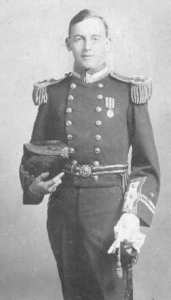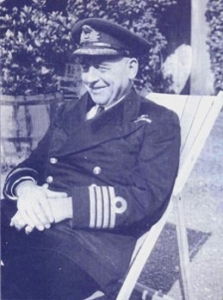Captain
Canada’s Most Decorated Naval Officer

Frederic Thornton Peters in 1918, following the end of the First World War. Photo courtesy of Sam McBride.
Canada`s most decorated naval hero, Captain Frederic Thornton “Fritz” Peters, VC, DSO, DSC and bar, DSC (U.S.), RN, has the rare distinction of receiving multiple awards for valour in each of the world wars.
He was born in Charlottetown, Prince Edward Island in 1889, but lived in Victoria, BC from age eight until joining the Royal Navy in January 1905 at 15. The Peters family lived in Oak Bay and later Esquimalt before moving to Prince Rupert in 1911.
Peters was nicknamed Fritz by his family because he was obsessed with all things military from his earliest years – like a stereotypical Prussian. In P.E.I. he was keen on a career as a soldier like his grandfather, the Father of Confederation Col. John Hamilton Gray, but in B.C. his interest changed to navy as a result of watching warships of the Royal Navy pass by within sight of his home.
The navy further caught his interest when he joined others in his family in visits to his cousin Col. James Peters and his family in Esquimalt, including tours of the naval base and British warships. Col. Peters, who like Fritz’s father Frederick was a great-grandson of Loyalist James Peters from Hempstead, New York, was District Officer Commanding in BC until transferring to Toronto in 1899. Col. Peters, whose military career began in 1872 and included mention in dispatches in the Riel Rebellion of 1885, transferred back to Esquimalt in 1909, retired the following year, and went on to be one of the new municipality of Esquimalt’s first councilors.
In Victoria Fritz Peters was a student of Rev. William Washington Bolton, former rector of St. Paul’s Church, who ran a small school out of his home on Belcher Avenue. In his schools Bolton emphasized character building ahead of scholarship, with plenty of team sports, outdoor activities and boxing in the tradition of British private schools. In 1906 Bolton co-founded University School, now known as St. Michael’s University School.
Starting in 1900, Peters attended private schools in England, including three terms at a preparatory school in Maidenhead, England where navy courses were part of the curriculum.
Peters’ military career encompassed three stints of service. After cadet training in 1905, he went to sea as a midshipman with the Channel Fleet, and then service on gunboats and destroyers in the China Station of Weihai before retirement as a lieutenant in 1913.
At the outbreak of war in 1914 he rejoined, and served on destroyers, first as senior officer and later as a commander, until retirement as lieutenant commander in 1920.
Two of his brothers died early in the war. On April 24, 1915 Private John Francklyn Peters died while serving with the 7th British Columbia battalion in the Second Battle of Ypres when poison gas was used for the first time in a German offensive. Lieutenant Gerald Hamilton Peters died in the Mount Sorrel counterattack in the Ypres Salient on June 3, 1916, also serving with the 7th B.C. battalion.
While serving as a lieutenant on the destroyer HMS Meteor in the Battle of Dogger Bank in January 1915, Fritz was mentioned in dispatches and received the Distinguished Service Order (DSO) medal for his actions that saved the lives of two ratings when the ship’s engine room was hit by a shell from the German cruiser Blucher. He was the first Canadian in the war to receive the DSO, the medal for bravery second only to the Victoria Cross.
Later in the Great War he took command of destroyers and received the Distinguished Service Cross (DSC) in 1918 for “showing exceptional initiative, ability and zeal in submarine hunting operations and complete disregard of danger, exceptional coolness and ingenuity in his attacks on enemy submarines.” His navy colleagues particularly admired his courage and skill in hazardous rescues at sea where enemy subs were a constant threat.
Peters’ last recorded time spent in Canada was in organizing the funeral of his father, former P.E.I. Premier Frederick Peters, in Victoria BC in August 1919. Fred Peters was buried at Ross Bay Cemetery next to his daughter Violet Peters, who died in 1905 at age six in a fireplace accident at the family home in the Oak Bay area of the city.
Peters spent most of the inter-war years working in the Gold Coast colony in west Africa now known as Ghana. He also manufactured specialized pumps for a new type of midget submarine developed by his friend Cromwell Varley, DSO, RN.
When the Second World War broke out in 1939, he rejoined the Royal Navy, commanding a flotilla of anti-sub trawlers that sank two enemy subs, earning a bar to his Distinguished Service Cross in 1940. He later went back and forth between naval service and work with Section D (for destruction) of Britain`s Secret Intelligence Service, including command of a spying and sabotage school in Hertfordshire for expatriates who returned to their native countries in Occupied Europe to combat the Nazis.
In 1942 he took charge of the most dangerous mission in the Allied invasion of North Africa – an audacious attack by a mostly American force in two former U.S. Coast Guard cutters to secure Oran harbour in the French colony of Algeria for the invasion. Landings at 1 am on Nov. 8, 1942 on beaches west and east of Oran by American troops had met little resistance from French defenders, but two hours later they reacted with full force from Oran shore batteries and warships moored in the harbour when Peters’ ship HMS Walney along with HMS Hartland broke through a boom of logs, chains and barges and proceeded towards their goal of taking over French warships and port facilities with commandos.
Despite suffering 90% casualties and facing point blank fire from all directions, Peters was able to direct his ship for a mile and a half through the narrow harbour and land Walney beside its target berth. At great personal risk, he assisted with the landing lines in the front and back of the 250 ft.-long ship. Wounded in the shoulder and blinded in one eye, he was taken prisoner along with fellow survivors. Two days later he was freed by American troops who had captured the city, and carried through the streets of Oran in triumph.
Tragically, three days later, on Friday, November 13, 1942 he died when the Sunderland flying boat transporting him from Gibraltar back to England encountered fierce headwinds and then heavy fog and instrument failure that resulted in the plane crashing into Plymouth Sound, flipping over and splitting apart. The 11 Royal Australian Air Force (RAAF) crew members miraculously all survived the crash, but Peters and the four other VIP passengers died, either from the impact of the crash or from exposure in the water. Unhurt in the crash, the pilot, Flight Lieutenant Wynton Thorpe, found Peters still alive in the water and valiantly tried to drag him to safety as he swam to a breakwater, giving up in exhaustion after about an hour when it was obvious that Peters was dead. A rescue boat from shore arrived about half an hour later to pick up survivors.
For his part in the action at Oran, Algeria Frederic Peters posthumously received both the Victoria Cross and the U.S. Distinguished Service Cross, the highest honour the Americans bestowed on foreigners.
After her husband’s death in 1919 Peters’ mother Bertha Gray Peters went to live with her daughter Helen Dewdney’s family in the West Kootenay region of southeastern B.C. It was at the Dewdney home in Nelson on February 2, 1944 that the U.S. Distinguished Service Cross was presented to Bertha as Peters’ next-of-kin by a delegation representing President Roosevelt that included officers from Edmonton and a brass band. Bertha – crippled and bedridden as a result of a serious fall down stairs a decade earlier – was angry when Peters’ Victoria Cross arrived in the regular mail with no ceremony, such a stark contrast to the respectful American presentation.
At the time, the unceremonious delivery of the Victoria Cross was believed to be an administrative error in wartime. But in fact Peters’ VC was intentionally downplayed by the British government to avoid offending the French who had resumed as allies against Hitler and did not like to be reminded of their vigorous action against the Allies in Oran harbour. Military files that became public in the 1970s show that British Admiral Andrew Cunningham issued an order on December 13, 1942 that “silence is the best policy” regarding the Oran VC.
Publicity in Canada about Peters’ Victoria Cross was generated more by his friends and family than through official channels. At the urging of the Nelson Board of Trade, a mountain of modest height on the western outskirts of Nelson was named Mt. Peters in his honour in March 1946, just a few months before his mother`s death. The only memorial for him in Britain is the listing of his name on the Portsmouth Naval Memorial among sailors of all ranks lost at sea.
In a letter to his father in 1916, Peters said he intended to enter politics in B.C. after the war, but that didn`t happen, as he found his best prospects for civilian work were through his navy contacts in Africa and Britain. In his last letter sent to his sister in March 1942 he said he hoped to return to B.C. to visit her after the war, “whenever that may be and if one is still in the land of the living.”
In June 1956 Helen Dewdney represented her late brother at ceremonies in England marking 100 years since the Victoria Cross was established by Queen Victoria. In 1985 a Plymouth recreational diver spotted the wreckage of the flying boat. The recovered propeller is now on display at an RAAF museum in Perth, Australia.


 CFB Esquimalt Naval and Military Museum
CFB Esquimalt Naval and Military Museum CFB Esquimalt Naval and Military Museum
CFB Esquimalt Naval and Military Museum
 CFB Esquimalt Naval and Military Museum
CFB Esquimalt Naval and Military Museum CFB Esquimalt Naval and Military Museum
CFB Esquimalt Naval and Military Museum CFB Esquimalt Naval and Military Museum
CFB Esquimalt Naval and Military Museum CFB Esquimalt Naval and Military Museum
CFB Esquimalt Naval and Military Museum CFB Esquimalt Naval and Military Museum
CFB Esquimalt Naval and Military Museum CFB Esquimalt Naval and Military Museum
CFB Esquimalt Naval and Military Museum
